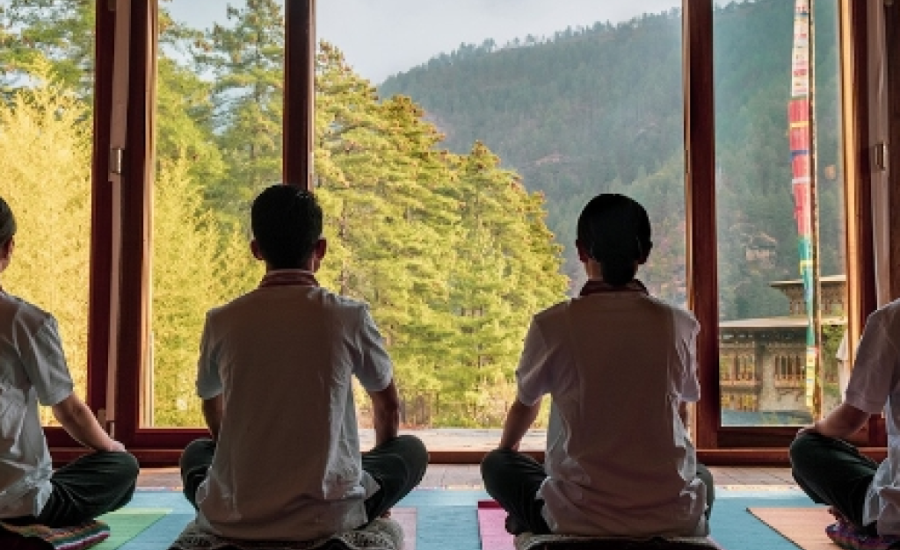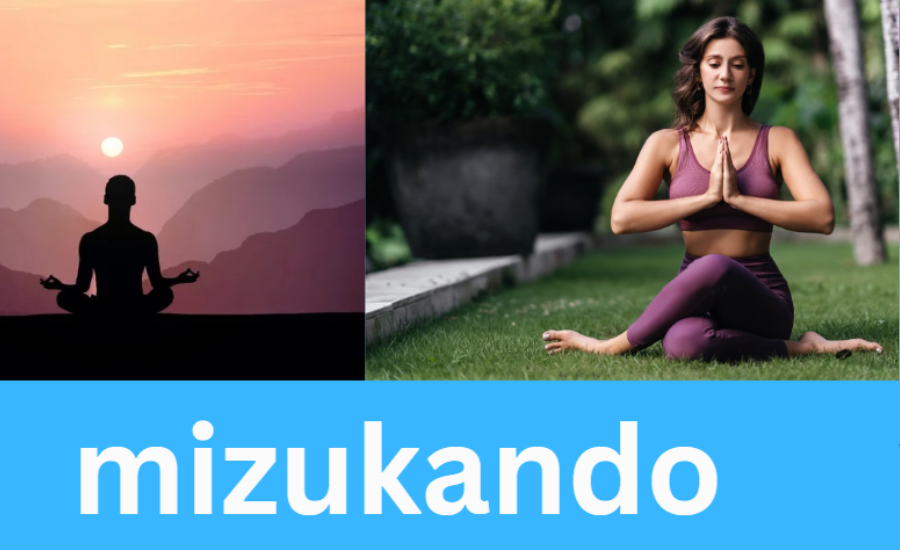
Exploring Mizukando: The Ancient Japanese Practice Merging Meditation And Water
In the world of mindfulness and meditation, an ancient Japanese practice known as mizukando has been gaining increased recognition. This distinct meditation method integrates the calming qualities of water with mindful practices, offering a pathway to achieving a profound state of tranquility and balance.
What Is Mizukando?
Mizukando, roughly meaning “the way of water,” is a time-honored Japanese meditation technique that places water at the core of its practice. By focusing on water’s serene and ever-flowing nature, this method enhances meditation, helping individuals attain a deeper state of relaxation, mental clarity, and connection with nature.
Key Features Of Mizukando:
Water as a Meditation Focus
The practice involves water as a central point of concentration during meditation sessions, guiding the mind toward stillness and peace.
Mindfulness and Visualization
It combines mindful breathing techniques with the power of visualization, allowing practitioners to immerse themselves fully in the meditative process.
Nature and Inner Connection
A crucial aspect of mizukando is fostering a sense of harmony with nature, emphasizing the bond between the individual and the natural world.
Cultivating Adaptability and Flow
This practice encourages a sense of adaptability and fluidity, helping practitioners navigate life’s challenges with the ease and resilience often associated with the nature of water.
The Origins Of Mizukando
Historical Background
Although the precise origins of mizukando are somewhat shrouded in mystery, it is thought to have emerged during Japan’s Edo period (1603-1867), a time when many traditional Japanese arts and cultural practices were refined and formalized. This period saw the development of various spiritual and meditative disciplines that shaped Japan’s rich cultural heritage, and mizukando is believed to have evolved from this spiritual climate.
Influence of Shinto and Buddhism
Mizukando is deeply influenced by both Shintoism and Buddhism, two prominent spiritual traditions in Japan that hold water in high regard. In Shinto, water is considered a purifying element, symbolizing cleansing and renewal. In Buddhist teachings, water reflects the impermanent, ever-changing nature of life, serving as a metaphor for adaptability and flow in the face of life’s uncertainties. These philosophies helped shape mizukando, making it a practice rooted in both spiritual purification and mindful acceptance of life’s fluidity.
Principles Of Mizukando

Balance and Harmony
A fundamental principle of mizukando is the pursuit of balance and harmony between all elements involved. This focus ensures that no single aspect overshadows the others, fostering an environment where tranquility and cohesion thrive. The careful arrangement of each component creates a serene space conducive to peace and well-being.
Mindfulness and Reflection
Mizukando emphasizes mindfulness and deep reflection. Every element—from the placement of stones to the movement of water—serves to cultivate a state of meditation and inner calm. The practice encourages practitioners to remain present and fully engaged, reflecting on the subtle beauty around them.
Simplicity and Minimalism
At the heart of mizukando is the principle of simplicity and minimalism. The practice shuns excessive decoration, instead embracing the elegance found in nature’s raw form. By focusing on the thoughtful arrangement of natural elements, mizukando captures a timeless beauty, inviting practitioners to appreciate the art of simplicity.
Mizukando: A Beginner’s Guide To Water Meditation
For those new to meditation, mizukando offers a simple and approachable way to start your practice. Unlike other meditation methods that may rely on specific techniques or postures, mizukando revolves around the soothing qualities of water. This makes it an easy-to-follow yet powerful technique for beginners looking to cultivate mindfulness and relaxation.
Creating Your Meditation Space
To begin practicing mizukando, choose a peaceful environment where you can focus without distractions. This could be a natural setting near a stream or pond, or even a calming spot in your home using a small water feature. The essential aspect is to have a source of water that you can listen to throughout your meditation. Once your space is ready, sit comfortably, close your eyes, and take deep breaths to center yourself and ease into the moment.
Starting Your Mizukando Meditation
When you’re settled, let your attention be drawn to the sound of the water. Allow its steady flow to clear your mind and bring about a sense of calm. If you find your thoughts drifting, gently guide your focus back to the water’s rhythm. With regular practice, you’ll notice that it becomes easier to remain present, making mizukando a fulfilling and peaceful addition to your meditation routine.
Practical Applications Of Mizukando
Mizukando, with its calming water-centric design, has been embraced in multiple sectors due to its unique ability to merge functionality with aesthetic harmony.
Residential Design
Many Japanese homes have adopted the principles of mizukando, utilizing water elements to create living spaces that are not only practical but also serene and visually appealing. By incorporating flowing water features into their design, homeowners can create a peaceful atmosphere that promotes relaxation and mindfulness within their personal environments.
Commercial Architecture
In the business world, mizukando is being integrated into commercial architecture as a way to build stronger connections between businesses, their environments, and their clientele. These water-focused designs offer companies a distinctive approach to enhancing customer experiences, creating spaces that feel welcoming and harmonious.
Public and Cultural Spaces
Mizukando has also been applied in the design of public buildings and cultural centers, where its tranquil aesthetics can deepen the cultural relevance of the space. Incorporating water elements into these areas fosters community engagement, offering a serene environment where visitors can feel a stronger connection to both the space and its cultural significance.
The Benefits Of Mizukando For Stress Relief
Mental and Emotional Wellness
Mizukando provides significant benefits, particularly in reducing stress and promoting emotional well-being. The serene sound of flowing water serves as a natural aid in lowering anxiety, offering a gentle method to manage the everyday pressures of life. By engaging in mizukando, you immerse yourself in the tranquil rhythms of water, allowing your mind and body to unwind.
Physical Relaxation and Focus
By directing your attention to the movement and sounds of water during meditation, mizukando encourages you to release distractions and mental clutter. This focus on the present moment reduces the grip of stress, promoting a sense of physical relaxation and control. With consistent practice, mizukando can help you develop stronger stress-coping skills, making it easier to face life’s challenges calmly and effectively.
Enhanced Overall Well-Being
Incorporating mizukando into your daily routine can greatly enhance your overall sense of well-being. The practice offers a quiet, reflective space where you can disconnect from external pressures and rejuvenate your mind. Regular moments of peaceful contemplation help restore mental clarity and equip you with renewed energy to tackle the demands of everyday life.
The Philosophy Behind Mizukando
At the heart of mizukando lies a philosophy focused on cultivating harmony with the natural world. This practice is built on the belief that water not only sustains life but also serves as a reflection of one’s inner state. By meditating near bodies of water, practitioners aim to still their minds, release negative emotions, and find inner peace.
Water’s constant movement and adaptability symbolize the fluid and ever-changing nature of life. It teaches the importance of resilience, encouraging practitioners to navigate life’s challenges gracefully, just as water effortlessly moves around obstacles on its path toward the ocean. This core philosophy promotes flexibility, acceptance, and a calm approach to the ups and downs of daily existence.
How To Incorporate Mizukando Into Daily Life
Introducing mizukando into your everyday routine can offer a transformative shift toward mindfulness and inner balance. These practices foster a deeper connection with the present moment, helping to sharpen your awareness.
To enhance your meditation sessions, consider integrating the calming presence of water. Whether through ambient water sounds or visualizing serene water scenes, this element can deepen your focus and amplify relaxation during meditation.
Explore creative outlets, such as journaling or painting, inspired by the core principles of mizukando. Expressing emotions through art provides a channel for emotional clarity and mental release, offering a deeper connection with your inner self.
Additionally, make time for nature walks, particularly in environments near bodies of water. Being in proximity to natural water sources can evoke a sense of peace and provide an opportunity to reflect on your personal journey toward balance and growth.
Lastly, share mizukando with friends or family to cultivate a community that embraces this philosophy. Engaging with others in the practice can enhance collective well-being and foster meaningful connections.
Mizukando And Modern Scientific Insights
While mizukando is deeply rooted in ancient Japanese traditions, contemporary science has begun to uncover the potential benefits of this water-focused meditation practice.
Neuroscientific Discoveries
Recent advancements in neuroscience, particularly through the use of functional magnetic resonance imaging (fMRI), have highlighted the effects of water environments on brain function.
- Increased activation in brain regions responsible for relaxation and emotional well-being.
- Reduced activity in regions associated with stress and anxiety.
- Enhanced communication between different parts of the brain, which may contribute to better overall cognitive performance.
The Blue Mind Concept
The “Blue Mind” theory, introduced by marine biologist Wallace J. Nichols, mirrors many of the ideas found in mizukando. According to this theory, being near water can naturally evoke a mildly meditative state, leading to:
- Lower stress levels
- An improved sense of mental and emotional well-being
- Enhanced cognitive abilities, including memory and concentration
- A boost in creativity and problem-solving skills
Mizukando In Japanese Gardens
Elevating Aesthetic Appeal
Mizukando plays a key role in enhancing the beauty of traditional Japanese gardens. By thoughtfully integrating water elements with natural surroundings, this practice creates a peaceful and visually captivating landscape.
Crafting Peaceful Retreats
A primary goal of incorporating mizukando in these gardens is to establish serene spaces that inspire relaxation and reflection. These gardens often serve as sanctuaries from the demands of everyday life, offering a quiet place for introspection.
Deep Cultural Roots
Mizukando holds significant cultural value in Japan, reflecting the nation’s deep respect for nature. It embodies Japan’s dedication to creating harmonious living environments that align with the natural world.
The Spiritual Dimensions Of Mizukando And Water

The Sacred Role of Water
In numerous spiritual traditions, water holds profound significance, and mizukando is deeply intertwined with this symbolism. In this practice, water transcends its physical presence to embody spiritual essence. The dynamic flow of water in mizukando represents purity, transformation, and the ceaseless progression of life. This spiritual aspect enhances the meditation experience, fostering a stronger bond with nature and one’s inner self.
Water’s Symbolic Meaning
Meditating with water in mizukando serves as a reminder of its rejuvenating and purifying qualities. Just as water effortlessly moves and adjusts, this practice encourages you to embrace change and find serenity in the present moment. This deep spiritual connection to water makes mizukando an enriching practice for those pursuing not only relaxation but also personal and spiritual development.
Enhancing Global Awareness
Engaging in mizukando can also deepen your awareness of your surroundings. By centering your focus on the natural element of water, you gain a greater understanding of the interconnectedness of all things. This heightened awareness fosters a deeper sense of gratitude and appreciation for the environment, making mizukando a valuable practice for enriching your spiritual and worldly perspective.
How To Practice Mizukando: A Step-by-Step Guide
1. Select a Tranquil Location:
Find a peaceful spot where you can comfortably sit or stand beside a water source. Ensure the environment is calm and free from disturbances to enhance your meditation experience.
2. Observe the Water:
Start by attentively observing the water. Pay attention to its movement, the sounds it makes, and how it interacts with its surroundings. Immerse yourself fully in this experience, allowing the natural flow of water to captivate your focus.
3. Practice Deep Breathing:
Engage in deep, mindful breathing. Breathe in deeply through your nose, then release the air slowly through your mouth. Visualize the water as it clears away mental clutter and negative thoughts, helping to refresh your mind.
4. Reflect on the Concept of Flow:
While maintaining your focus on the water, contemplate the idea of flow. Consider how water seamlessly adjusts to obstacles and continues its journey. Reflect on how you can incorporate this adaptable mindset into your own life.
5. Release and Let Go:
Allow any lingering thoughts or stress to drift away, similar to how leaves float downstream. Release any tension in your mind and body, and fully embrace the present moment.
6. Conclude with Gratitude:
Finish your meditation by taking a moment to express gratitude for the experience and the calming presence of the water. Acknowledge the peace and clarity you’ve gained.
Challenges And Limitations Of Mizukando
1. Architectural Constraints:
Incorporating mizukando into architectural designs involves meticulous planning and precise execution. Integrating natural elements such as water requires a thoughtful approach to maintain both functionality and aesthetic appeal.
2. Urban Restrictions:
In densely populated urban areas, implementing mizukando principles can be challenging due to limited space and resources. The constraints of urban environments may restrict the ability to create expansive and harmonious water features.
3. Balancing Tradition with Contemporary Needs:
Architects face the challenge of blending traditional mizukando elements with modern requirements. Achieving this balance is crucial for preserving the essence of the practice while accommodating contemporary lifestyles and expectations.
Recent Innovations In Mizukando

1. Integration of Smart Technologies:
Advancements in smart technology offer new opportunities for enhancing mizukando spaces. Incorporating smart home systems can provide better control over environmental conditions and improve the efficiency of water features, enriching the overall user experience.
2. Cutting-Edge Projects:
Recent innovative projects highlight the evolving applications of mizukando. Examples include eco-conscious residential developments and community hubs that integrate mizukando principles, demonstrating how traditional practices can be adapted to modern contexts.
The Future Of Mizukando
As the field of mindfulness and alternative meditation practices expands, the ancient practice of mizukando is poised to receive increased attention and integration. Possible future advancements in mizukando include:
Expanded Scientific Exploration
Future research is expected to delve deeper into the benefits of water-based meditation. Scientists will likely study how mizukando impacts mental health, stress reduction, and overall well-being in more detail, potentially providing further validation of its therapeutic effects.
Integration into Therapeutic Modalities
Mizukando principles may find their way into various therapeutic practices, such as occupational therapy and stress management programs. This integration could help enhance treatment approaches by incorporating the calming effects of water into therapeutic environments.
Technology-Enhanced Practices
With technological advancements, mizukando may be adapted through virtual reality and other digital tools. These innovations could provide immersive water-based meditation experiences for individuals who do not have access to natural water settings, broadening the practice’s reach.
Environmental and Educational Applications
Mizukando might also play a role in environmental education and conservation efforts. By promoting a deeper connection with natural elements, it could support initiatives aimed at fostering environmental stewardship and awareness.
FAQs About Mizukando
1. What is Mizukando?
Mizukando is a traditional Japanese meditation practice that incorporates water as a central element. It combines the calming properties of water with mindfulness and visualization techniques to enhance relaxation and inner peace.
2. How do I start practicing Mizukando?
To begin, find a quiet place with access to water, such as a stream or a small indoor water feature. Sit comfortably, focus on the sound and movement of the water, and take deep breaths. Allow the water to guide your thoughts and bring your mind to a state of calm.
3. What are the benefits of practicing Mizukando?
Practicing Mizukando can help reduce stress, improve mental clarity, and promote overall well-being. The calming effect of water aids in relaxation and helps manage daily stressors, contributing to a greater sense of peace and balance.
4. Can Mizukando be used in urban environments?
While Mizukando is traditionally practiced near natural water sources, urban practitioners can adapt by using indoor water features or virtual water environments. The key is to create a soothing, water-based focus for meditation.
5. How does Mizukando integrate with modern technology?
Recent innovations may include the use of virtual reality to simulate water environments, allowing individuals to practice Mizukando even if they lack access to natural water sources. This tech-assisted approach aims to make the practice more accessible.
6. What challenges might I face with Mizukando?
Challenges may include finding suitable spaces for practice, especially in densely populated urban areas, and balancing traditional practices with modern needs. Architects and practitioners might also encounter difficulties in incorporating water elements effectively.
Conclusion
Mizukando offers a unique and serene approach to meditation by harnessing the calming influence of water. Rooted in ancient Japanese traditions, it provides a refreshing alternative to more conventional meditation practices. Despite its challenges, such as integrating traditional principles in modern settings and finding suitable practice environments, the potential benefits make it a compelling practice for enhancing mental and emotional well-being. As interest in mindfulness grows, mizukando is likely to evolve, incorporating technological advancements and broader applications to continue enriching lives through its profound connection to nature and inner peace.
Stay informed with the latest news and updates on Mumbaibreaking

